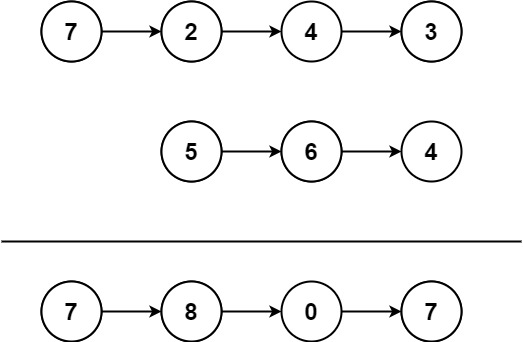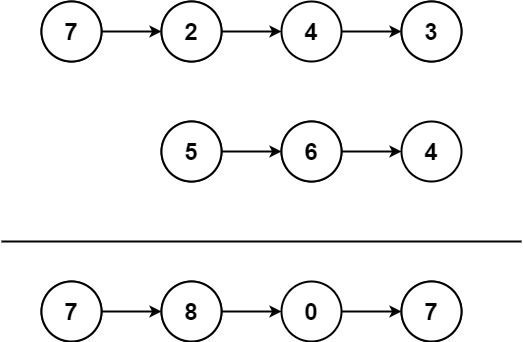英文原文
You are given two non-empty linked lists representing two non-negative integers. The most significant digit comes first and each of their nodes contains a single digit. Add the two numbers and return the sum as a linked list.
You may assume the two numbers do not contain any leading zero, except the number 0 itself.
Example 1:

Input: l1 = [7,2,4,3], l2 = [5,6,4] Output: [7,8,0,7]
Example 2:
Input: l1 = [2,4,3], l2 = [5,6,4] Output: [8,0,7]
Example 3:
Input: l1 = [0], l2 = [0] Output: [0]
Constraints:
- The number of nodes in each linked list is in the range
[1, 100]. 0 <= Node.val <= 9- It is guaranteed that the list represents a number that does not have leading zeros.
Follow up: Could you solve it without reversing the input lists?
中文题目
给你两个 非空 链表来代表两个非负整数。数字最高位位于链表开始位置。它们的每个节点只存储一位数字。将这两数相加会返回一个新的链表。
你可以假设除了数字 0 之外,这两个数字都不会以零开头。
示例1:

输入:l1 = [7,2,4,3], l2 = [5,6,4] 输出:[7,8,0,7]
示例2:
输入:l1 = [2,4,3], l2 = [5,6,4] 输出:[8,0,7]
示例3:
输入:l1 = [0], l2 = [0] 输出:[0]
提示:
- 链表的长度范围为
[1, 100] 0 <= node.val <= 9- 输入数据保证链表代表的数字无前导 0
进阶:如果输入链表不能修改该如何处理?换句话说,不能对列表中的节点进行翻转。
通过代码
高赞题解
🙋♀️就喜欢这种短短的打卡题,短短的打个卡,短短的发个题解,哎又是美妙的夜晚!
update:统一回复下头插法的评论,不熟悉的可以用迭代法去做做 206. 反转链表,需要链表逆序的时候就用头插法。
用 stack 保存链表,再从 stack 中取出来,就是数字从低位到高位访问了。
class Solution {
public ListNode addTwoNumbers(ListNode l1, ListNode l2) {
Stack<Integer> stack1 = new Stack<>();
Stack<Integer> stack2 = new Stack<>();
while (l1 != null) {
stack1.push(l1.val);
l1 = l1.next;
}
while (l2 != null) {
stack2.push(l2.val);
l2 = l2.next;
}
int carry = 0;
ListNode head = null;
while (!stack1.isEmpty() || !stack2.isEmpty() || carry > 0) {
int sum = carry;
sum += stack1.isEmpty()? 0: stack1.pop();
sum += stack2.isEmpty()? 0: stack2.pop();
ListNode node = new ListNode(sum % 10);
node.next = head;
head = node;
carry = sum / 10;
}
return head;
}
}统计信息
| 通过次数 | 提交次数 | AC比率 |
|---|---|---|
| 86395 | 146412 | 59.0% |
提交历史
| 提交时间 | 提交结果 | 执行时间 | 内存消耗 | 语言 |
|---|
相似题目
| 题目 | 难度 |
|---|---|
| 两数相加 | 中等 |




